In business since 1837, Procter & Gamble has grown into one of the world’s largest consumer goods manufacturers, advertisers, and distributors. It currently sells 65 products in more than 180 countries.
Some of its leading brands are Luvs, Pampers, Tampax, Charmin, Downy, Tide, Cascade, Dawn, Febreze, Head & Shoulders, Old Spice, Pantene, Gillette, Braun, Crest, and Oral-B.

Here’s a look at Procter & Gamble’s segments. Over 70% of its earnings are accounted for by Fabric & Home Care (27%); Baby, Feminine & Family Care (25%), and Beauty (19%).
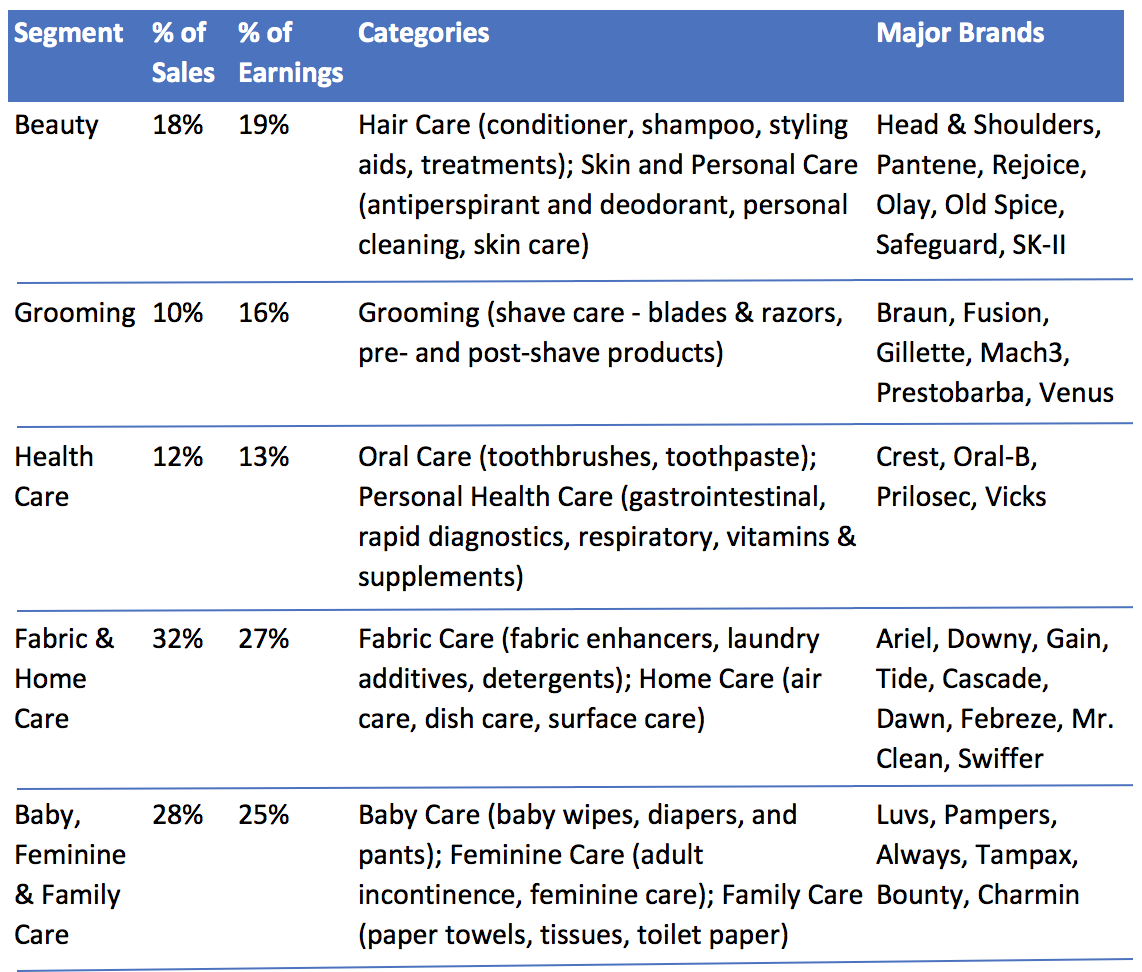
Procter & Gamble’s business is very diversified geographically. North America accounted for 45% of sales in fiscal 2017, followed by Europe (23%), Asia Pacific (9%), Greater China (8%), Latin America (8%), and India, Middle East and Africa (8%). Emerging markets generate approximately 35% of company-wide sales.
Business Analysis
At first glance, it looks like Procter & Gamble is in deep trouble thanks to five straight years of declining sales. However, the company’s top line decline is largely a direct result of management’s long-term growth plan, which involves selling off over 100 non-core brands (roughly 15% of total revenue) to refocus R&D and ad budgets on the company’s most important cash cows, which offer stronger profitability and better growth prospects.
For example, prior to the slim down, Procter & Gamble had about 165 brands. However, the company’s 65 most successful brands, including its 21 mega-brands, which had annual sales of over $1 billion each, accounted for 90% and 95% of revenue and profits, respectively.
The company has now completed phase one of its growth plan, thanks to the sale of its last 41 ancillary brands to Coty (COTY) in 2016.
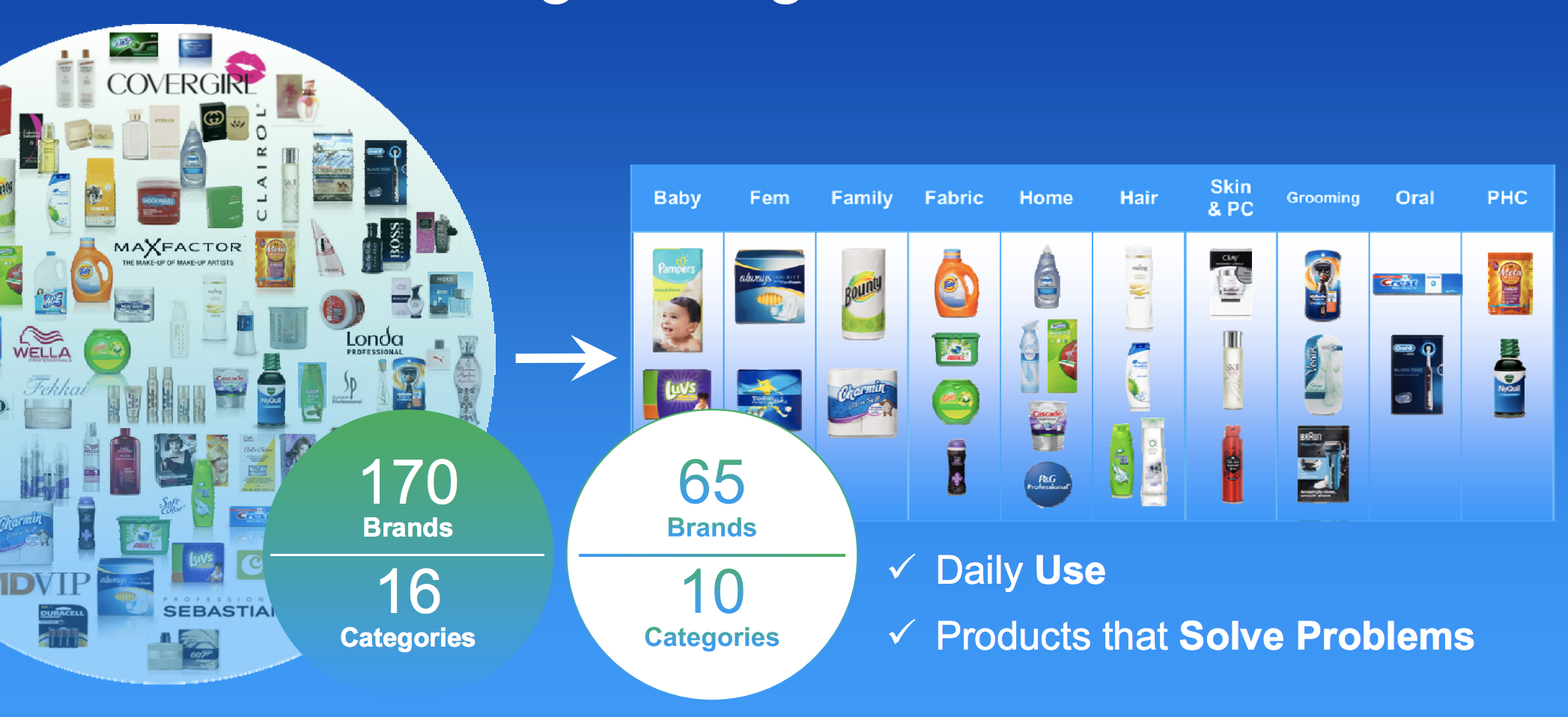
The company believes its more focused approach will allow it to deliver 1% higher long-term annual sales growth and deliver margins that are 200 basis points higher, which in a slow growth industry such as this is a meaningful benefit to shareholders.
Better yet, with fewer products to make, management has spent the last five years finding ways to squeeze more than $7 billion in inefficiencies out of its manufacturing and supply chains. However, management is just getting started.
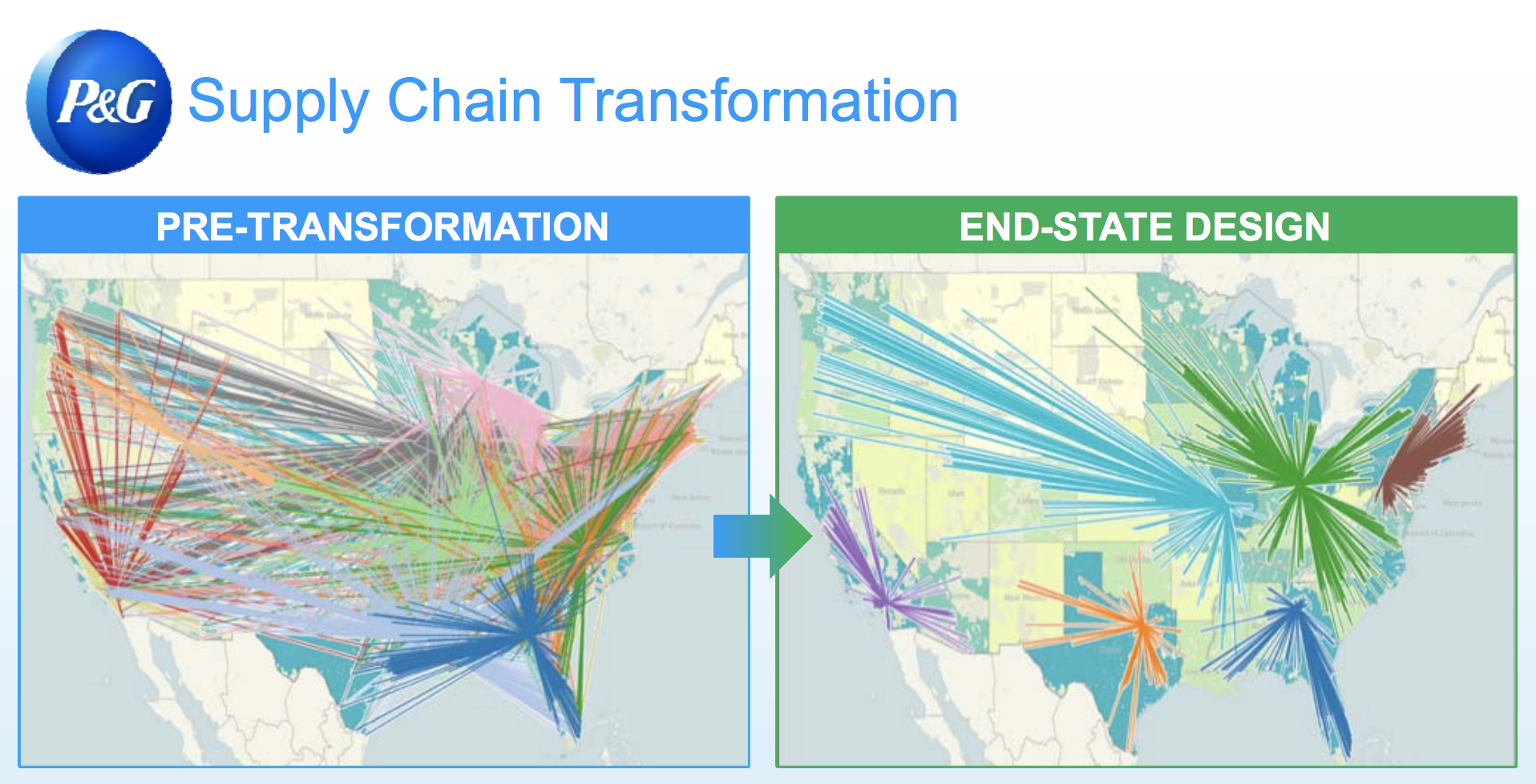
In fact, Procter & Gamble thinks that its leaner business model will allow it to cut another $10 billion from its production costs over the next five years, thanks in part to advances in manufacturing automation.
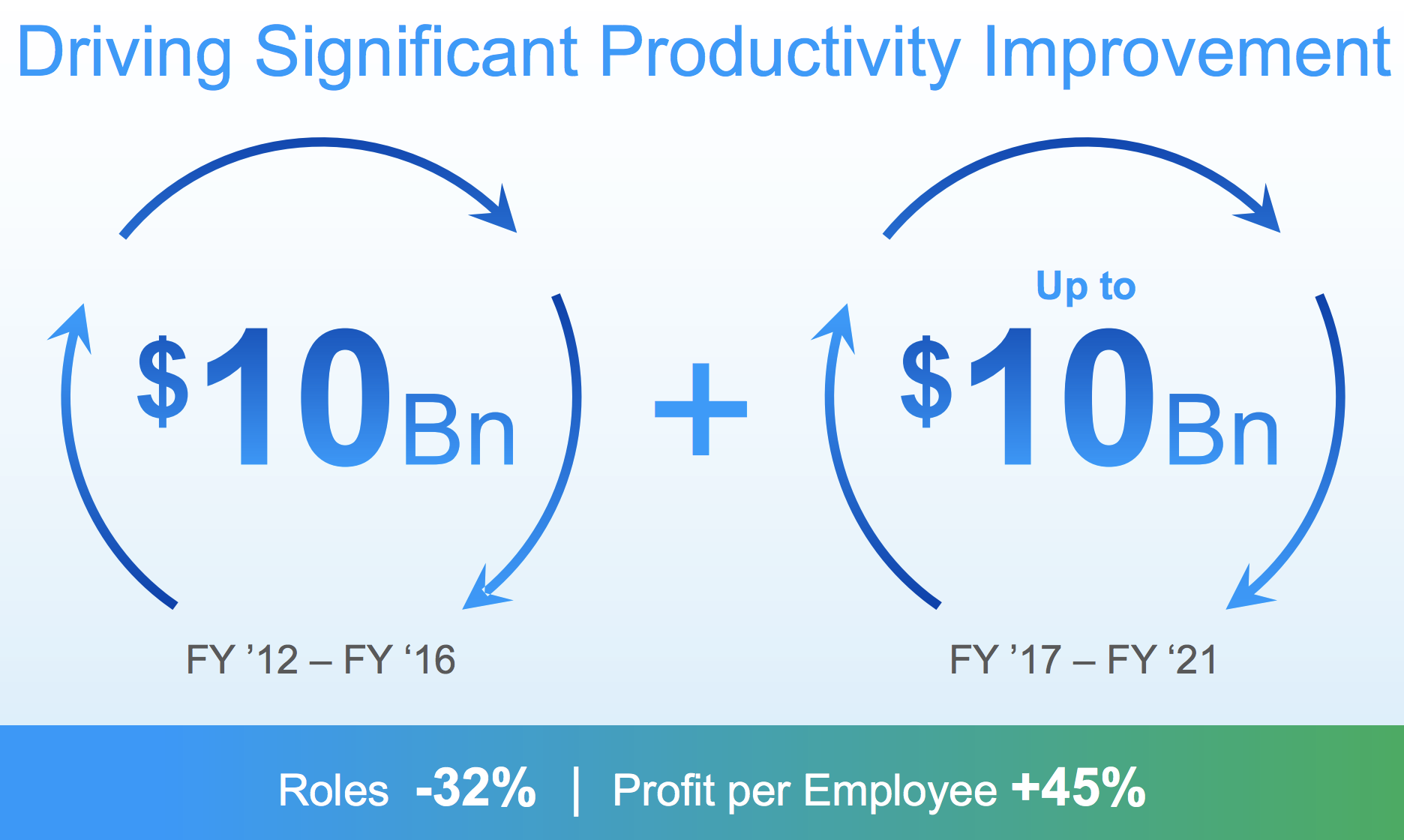
That is part of the reason why management has made an impressive goal to return up to $70 billion in cash to shareholders from fiscal 2016 through 2019. This will mostly be in the form of buybacks.
However, over the long-term, a vastly reduced share count will make growing the dividend easier (via a lower payout ratio), and thus help the company hopefully generate market-beating total returns in the future.
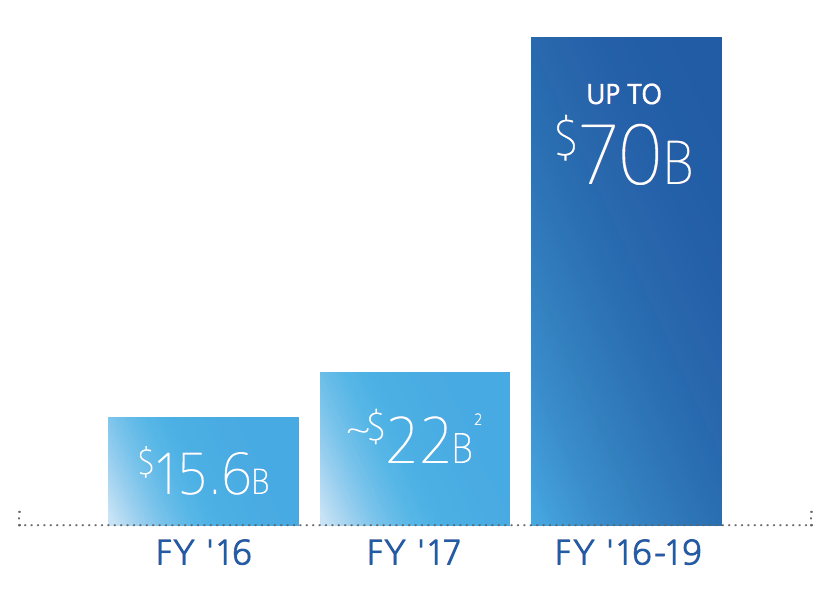
Business transformation aside, there are numerous reasons to be attracted to Procter & Gamble’s business. The company’s strengths begin with the firm’s deep understanding of and continuous adaptation to evolving consumer trends.
For example, P&G spends close to $2 billion each year on R&D, carrying out thousands of studies to gain consumer insights and develop relevant product technologies.
With the right products under its wings, P&G cranks up its advertising budget, which regularly exceeds $7 billion per year (more than 10% of sales). It’s no wonder why consumers are so familiar with most of the company’s brands.
As a result, P&G’s products have dominated the shelves at many retailers. Most of the company’s 20+ billion-dollar brands boast #1 or #2 positions in their category or segment, and P&G is #1 in seven of its 10 categories. Incredibly, P&G’s products touch approximately 5 billion consumers daily!
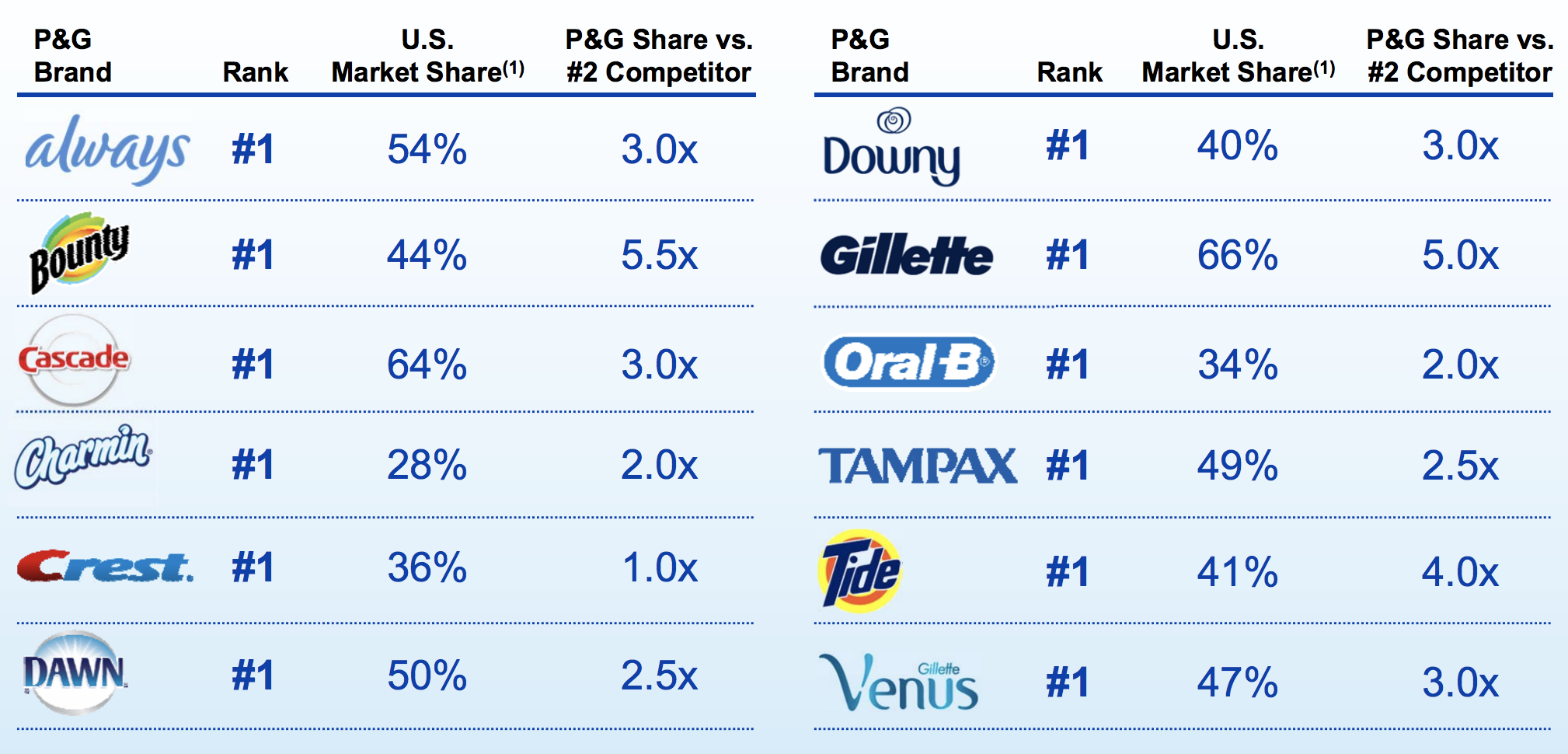
The company also boasts the largest e-commerce sales in its industry. Online sales grew 30% to reach $3 billion (4.6% of total revenue) in fiscal 2017. Many of its brands have leading positions among Millennials as well.
Importantly, non-food consumer products have historically been very sticky, resulting in a relatively slow pace of change. Roughly 85% of households in America are constantly filled with the same 150 items, according to IRI Market Advantage. Furthermore, 60% to 80% of all new product launches fail. This makes it all the more difficult for smaller rivals to break into P&G’s market share.
Overall, P&G is an absolute giant in the consumer staples sector and appears to have strong staying power. With nearly $10 billion of spending on R&D and advertising each year, extensive global distribution networks, recession-resistant products, plans to drive significant productivity savings, and a more focused portfolio of brands, Procter & Gamble should continue generating reliable cash flow for many years to come, even if growth remains a struggle.
Key Risks
Organic sales growth is at the heart of P&G’s struggles. The company has broadly lost market share over the past decade, driven by the continued rise of smaller brands, an overall lack of product innovation, and cost cuts that have helped boost short-term profits but perhaps at the expense of long-term growth.
You can see that P&G’s cumulative organic sales growth has significantly trailed the growth rates recorded by its large peers and the overall market.

Activist investor Nelson Peltz gained a seat on P&G’s board and seeks to help the company reverse market share losses and create more value for shareholders. Investors can view Peltz’s full critique of the company here.
Unlike what happens in certain activist investor campaigns, P&G is not expected take on substantial financial leverage, break up the company, or meaningfully slash spending on R&D and marketing. Peltz and P&G certainly face a tall task, especially in the company’s largest and most profitable market, North America.
Growth has been a big challenge as P&G’s relatively high prices and general lack of innovation have opened the door for new and existing players to take market share. Consumers are also getting smarter with how they shop, using their smartphones to compare prices and check out reviews on new, less expensive brands. Private label products continue closing the gap as well, with Costco’s Kirkland brand one of the most visible examples across numerous categories.
While the consumer goods and healthcare industry is defensive and enjoys a relatively slow pace of change, it is rife with cutthroat competition. Procter & Gamble must constantly be innovating in the form of new and improved versions of current hit brands in order to maintain and hopefully grow market share, which means taking on rivals such as Unilever (UL), Kimberly Clark (KMB), Clorox (CLX), and Colgate-Palmolive (CL), as well as many new entrants such as Dollar Shave Club.
In addition, while P&G invests billions each year into advertising to maintain its brand equity and the pricing power that goes with it, we can’t forget that in times of economic hardship consumer’s might always choose to go with generic store brands that pretty much do the same thing but at much lower prices.
In other words, while Procter & Gamble’s recent brand culling and hyper focus on efficiency and cost cutting might mean that margins jump in the short-term, don’t forget that those high margins need to be protected behind effective R&D and ad spending that routinely totals 14% to 15% of overall revenues.
Management’s ability to deliver on its promised efficiency initiatives are another major risk.
While current CEO David Taylor, a 35-year veteran of the company, has continued the previous management’s road map to cost cutting greatness, there is always the risk that the low hanging fruit has already been plucked.
In fact, if management gets too aggressive with cost cutting, including a 25% decrease in employee count over the last five yea, there is a risk that productivity and production innovation may continue to suffer.
To put it another way, P&G might have become so fond of cost cutting to grow earnings that it might end up cutting too deep and getting rid of not only unnecessary fat, but also muscle or bone. This is essentially what has happened to IBM over the past decade (combined with financial engineering gimmicks).
Finally, it’s worth mentioning that Procter & Gamble derives about 55% of its sales from outside the U.S. When the U.S. dollar strengthens, the company’s reported sales and earnings growth takes a hit.
However, currency exchange rate fluctuations shouldn’t have an impact on the company’s long-term earnings potential. By the far the biggest factors are management turning P&G back to profitable organic growth and executing on the cost savings targets.
Closing Thoughts on Procter & Gamble
Procter & Gamble has long been a favorite dividend stock for conservative investors. With a track record of paying a dividend every year since 1890, including more than 60 consecutive years of payout increases, the company’s reputation as a dependable income investment is well-earned.
However, as with all mature businesses, P&G’s sheer size has caused a number of growth and innovation challenges over the past decade. These issues do not seem insurmountable or likely to cause more pain than just a slow bleed over time, but they need to be thoughtfully addressed if the company is to continue its rich history of profitable long-term growth.
P&G’s portfolio transformation and profit growth initiatives are far from proven, but it’s encouraging to see the company be more proactive. Having an activist investor on the board to help bring in some fresh thinking seems like a positive as well.
Overall, the company’s strategic plans to improve organic growth and regain market share will take time to play out, but this blue chip dividend king should continue delivering rock solid income and low single-digit payout growth in the years ahead.
To learn more about P&G’s dividend safety and growth profile, please click here.




Leave A Comment